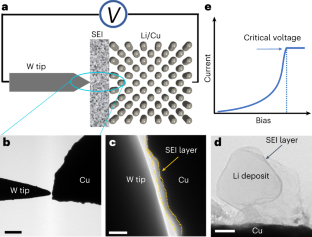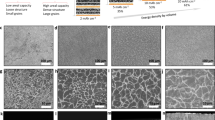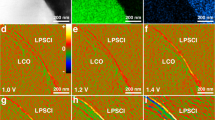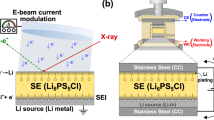Abstract
The solid–electrolyte interphase (SEI) critically governs the performance of rechargeable batteries. An ideal SEI is expected to be electrically insulative to prevent persistently parasitic reactions between the electrode and the electrolyte and ionically conductive to facilitate Faradaic reactions of the electrode. However, the true nature of the electrical properties of the SEI remains hitherto unclear due to the lack of a direct characterization method. Here we use in situ bias transmission electron microscopy to directly measure the electrical properties of SEIs formed on copper and lithium substrates. We reveal that SEIs show a voltage-dependent differential conductance. A higher rate of differential conductance induces a thicker SEI with an intricate topographic feature, leading to an inferior Coulombic efficiency and cycling stability in Li||Cu and Li||LiNi0.8Mn0.1Co0.1O2 cells. Our work provides insight into the targeted design of the SEI with desired characteristics towards better battery performance.
This is a preview of subscription content, access via your institution
Access options
Access Nature and 54 other Nature Portfolio journals
Get Nature+, our best-value online-access subscription
$29.99 / 30 days
cancel any time
Subscribe to this journal
Receive 12 digital issues and online access to articles
$119.00 per year
only $9.92 per issue
Buy this article
- Purchase on Springer Link
- Instant access to full article PDF
Prices may be subject to local taxes which are calculated during checkout





Similar content being viewed by others
Data availability
All data that support the findings of this study have been included in this article and its Supplementary Information. Source data are provided with this paper.
References
Xu, K. Electrolytes and interphases in Li-ion batteries and beyond. Chem. Rev. 114, 11503–11618 (2014).
Cheng, X. B., Zhang, R., Zhao, C. Z. & Zhang, Q. Toward safe lithium metal anode in rechargeable batteries: a review. Chem. Rev. 117, 10403–10473 (2017).
Lin, D. C., Liu, Y. Y. & Cui, Y. Reviving the lithium metal anode for high-energy batteries. Nat. Nanotechnol. 12, 194–206 (2017).
Peled, E. The electrochemical behavior of alkali and alkaline-earth metals in non-aqueous battery systems—the solid–electrolyte-interphase model. J. Electrochem. Soc. 126, 2047–2051 (1979).
Peled, E. & Menkin, S. Review—SEI: past, present and future. J. Electrochem. Soc. 164, A1703–A1719 (2017).
Wang, A., Kadam, S., Li, H., Shi, S. & Qi, Y. Review on modeling of the anode solid–electrolyte interphase (SEI) for lithium-ion batteries. npj Comput. Mater. 4, 15 (2018).
Xu, K. Interfaces and interphases in batteries. J. Power Sources 559, 232652 (2023).
Ma, Y. G. et al. Structure and reactivity of alucone-coated films on Si and LixSiy surfaces. ACS Appl. Mater. Inter. 7, 11948–11955 (2015).
Wang, L. N. et al. Identifying the components of the solid–electrolyte interphase in Li-ion batteries. Nat. Chem. 11, 789–796 (2019).
Shen, X. et al. The failure of solid–electrolyte interphase on Li metal anode: structural uniformity or mechanical strength? Adv. Energy Mater. 10, 1903645 (2020).
Winter, M. The solid–electrolyte interphase—the most important and the least understood solid electrolyte in rechargeable Li batteries. Z. Phys. Chem. 223, 1395–1406 (2009).
He, X. et al. The passivity of lithium electrodes in liquid electrolytes for secondary batteries. Nat. Rev. Mater. 6, 1036–1052 (2021).
Benitez, L. & Seminario, J. M. Electron transport and electrolyte reduction in the solid–electrolyte interphase of rechargeable lithium-ion batteries with silicon anodes. J. Phys. Chem. C 120, 17978–17988 (2016).
Lin, Y. X. et al. Connecting the irreversible capacity loss in Li-ion batteries with the electronic insulating properties of solid–electrolyte-interphase (SEI) components. J. Power Sources 309, 221–230 (2016).
Liu, Z. et al. Interfacial study on solid–electrolyte interphase at Li metal anode: implication for Li dendrite growth. J. Electrochem. Soc. 163, A592–A598 (2016).
Zhang, Q. L. et al. Synergetic effects of inorganic components in solid–electrolyte interphase on high cycle efficiency of lithium-ion batteries. Nano Lett. 16, 2011–2016 (2016).
Feng, M., Pan, J. & Qi, Y. Impact of electronic properties of grain boundaries on the solid-electrolyte interphases (SEIs) in Li-ion batteries. J. Phys. Chem. C 125, 15821–15829 (2021).
Smeu, M. & Leung, K. Electron leakage through heterogeneous LiF on lithium metal battery anodes. Phys. Chem. Chem. Phys. 23, 3214–3218 (2021).
Christensen, J. & Newman, J. A mathematical model for the lithium-ion negative electrode solid–electrolyte interphase. J. Electrochem. Soc. 151, A1977–A1988 (2004).
Single, F., Horstmann, B. & Latz, A. Dynamics and morphology of solid-electrolyte interphase (SEI). Phys. Chem. Chem. Phys. 18, 17810–17814 (2016).
Single, F., Horstmann, B. & Latz, A. Revealing SEI morphology: in-depth analysis of a modeling approach. J. Electrochem. Soc. 164, E3132–E3145 (2017).
Single, F., Latz, A. & Horstmann, B. Identifying the mechanism of continued growth of the solid–electrolyte interphase. ChemSusChem 11, 1950–1955 (2018).
Kobbing, L., Latz, A. & Horstmann, B. Growth of the solid–electrolyte interphase: electron diffusion versus solvent diffusion. J. Power Sources 561, 232651 (2023).
Harris, O. C., Lin, Y. X., Qi, Y., Leung, K. & Tang, M. H. How transition metals enable electron transfer through the SEI: part I. Experiments and Butler–Volmer modeling. J. Electrochem. Soc. 167, 013502 (2019).
Ploehn, H. J., Ramadass, P. & White, R. E. Solvent diffusion model for aging of lithium-ion battery cells. J. Electrochem. Soc. 151, A456–A462 (2004).
Attia, P. M., Das, S., Harris, S. J., Bazant, M. Z. & Chueh, W. C. Electrochemical kinetics of SEI growth on carbon black: part I. Experiments. J. Electrochem. Soc. 166, E97–E106 (2019).
Tang, M., Lu, S. D. & Newman, J. Experimental and theoretical investigation of solid–electrolyte-interphase formation mechanisms on glassy carbon. J. Electrochem. Soc. 159, A1775–A1785 (2012).
Riess, I. Four point Hebb–Wagner polarization method for determining the electronic conductivity in mixed ionic–electronic conductors. Solid State Ionics 51, 219–229 (1992).
Liu, Y. et al. Impacts of the properties of anode solid–electrolyte interface on the storage life of Li-ion batteries. J. Phys. Chem. C 122, 9411–9416 (2018).
Lorger, S., Usiskin, R. & Maier, J. Transport and charge carrier chemistry in lithium oxide. J. Electrochem. Soc. 166, A2215–A2220 (2019).
Stetson, C. et al. Three-dimensional electronic resistivity mapping of solid–electrolyte interphase on Si anode materials. Nano Energy 55, 477–485 (2019).
Santos, C. S., Botz, A., Bandarenka, A. S., Ventosa, E. & Schuhmann, W. Correlative electrochemical microscopy for the elucidation of the local ionic and electronic properties of the solid–electrolyte interphase in Li-ion batteries. Angew. Chem. Int. Ed. 61, e202202744 (2022).
Su, Y. et al. LiPON thin films with high nitrogen content for application in lithium batteries and electrochromic devices prepared by RF magnetron sputtering. Solid State Ion. 282, 63–69 (2015).
Han, F. et al. High electronic conductivity as the origin of lithium dendrite formation within solid electrolytes. Nat. Energy 4, 187–196 (2019).
Li, Y. Z. et al. Atomic structure of sensitive battery materials and interfaces revealed by cryo-electron microscopy. Science 358, 506–510 (2017).
Wang, X. F. et al. New insights on the structure of electrochemically deposited lithium metal and its solid–electrolyte interphases via cryogenic TEM. Nano Lett. 17, 7606–7612 (2017).
Zachman, M. J., Tu, Z., Choudhury, S., Archer, L. A. & Kourkoutis, L. F. Cryo-STEM mapping of solid–liquid interfaces and dendrites in lithium metal batteries. Nature 560, 345–349 (2018).
Xu, Y. et al. Atomic to nanoscale origin of vinylene carbonate enhanced cycling stability of lithium metal anode revealed by cryo-transmission electron microscopy. Nano Lett. 20, 418–425 (2020).
Ren, X. et al. Role of inner solvation sheath within salt–solvent complexes in tailoring electrode/electrolyte interphases for lithium metal batteries. Proc. Natl Acad. Sci. USA 117, 28603–28613 (2020).
Cao, X. et al. Effects of fluorinated solvents on electrolyte solvation structures and electrode/electrolyte interphases for lithium metal batteries. Proc. Natl Acad. Sci. USA 118, e2020357118 (2021).
Derosa, P. A. & Seminario, J. M. Electron transport through single molecules: scattering treatment using density functional and green function theories. J. Phys. Chem. B 105, 471–481 (2001).
Beltran, S. P. & Balbuena, P. B. SEI formation mechanisms and Li+ dissolution in lithium metal anodes: impact of the electrolyte composition and the electrolyte-to-anode ratio. J. Power Sources 551, 232203 (2022).
Rafferty, B. & Brown, L. M. Direct and indirect transitions in the region of the bandgap using electron-energy-loss spectroscopy. Phys. Rev. B 58, 10326–10337 (1998).
Liu, X. et al. Local electronic structure variation resulting in Li ‘filament’ formation within solid electrolytes. Nat. Mater. 20, 1485–1490 (2021).
Li, Y. S. & Qi, Y. Transferable self-consistent charge density functional tight-binding parameters for Li-metal and Li-ions in inorganic compounds and organic solvents. J. Phys. Chem. C 122, 10755–10764 (2018).
Xu, J. G. et al. Mechanical and electronic stabilization of solid–electrolyte interphase with sulfite additive for lithium metal batteries. J. Electrochem. Soc. 166, A3201–A3206 (2019).
Lu, D. P. et al. Failure mechanism for fast-charged lithium metal batteries with liquid electrolytes. Adv. Energy Mater. 5, 1400993 (2015).
Fang, C. et al. Quantifying inactive lithium in lithium metal batteries. Nature 572, 511–515 (2019).
Peled, E., Golodnitsky, D. & Ardel, G. Advanced model for solid–electrolyte-interphase electrodes in liquid and polymer electrolytes. J. Electrochem. Soc. 144, L208–L210 (1997).
Aurbach, D. et al. New insights into the interactions between electrode materials and electrolyte solutions for advanced non-aqueous batteries. J. Power Sources 81, 95–111 (1999).
Zhang, Z. et al. Capturing the swelling of solid-electrolyte interphase in lithium metal batteries. Science 375, 66–70 (2022).
Yu, Z. et al. Molecular design for electrolyte solvents enabling energy-dense and long-cycling lithium metal batteries. Nat. Energy 5, 526–533 (2020).
Li, J. et al. Dynamics of particle network in composite battery cathodes. Science 376, 517–521 (2022).
Liu, Y. et al. The DFT-ReaxFF hybrid reactive dynamics method with application to the reductive decomposition reaction of the TFSI and DOL electrolyte at a lithium metal anode surface. J. Phys. Chem. Lett. 12, 1300–1306 (2021).
Kresse, G. & Hafner, J. Ab initio molecular dynamics for liquid metals. Phys. Rev. B 47, 558–561 (1993).
Plimpton, S. Fast parallel algorithms for short-range molecular dynamics. J. Comput. Phys. 117, 1–19 (1995).
Kamphaus, E. P. & Balbuena, P. B. First-principles investigation of lithium polysulfide structure and behavior in solution. J. Phys. Chem. C 121, 21105–21117 (2017).
Perdew, J. P. & Wang, Y. Accurate and simple analytic representation of the electron-gas correlation energy. Phys. Rev. B 45, 13244–13249 (1992).
Frisch, M. J. et al. Gaussian 16 Rev. C.01 (Gaussian, 2016).
Kremer, J. R., Mastronarde, D. N. & McIntosh, J. R. Computer visualization of three-dimensional image data using IMOD. J. Struct. Biol. 116, 71–76 (1996).
Zhang, L. & Ren, G. IPET and FETR: experimental approach for studying molecular structure dynamics by cryo-electron tomography of a single-molecule structure. PLoS ONE 7, e30249 (2012).
Zhai, X. B. et al. LoTToR: an algorithm for missing-wedge correction of the low-tilt tomographic 3D reconstruction of a single-molecule structure. Sci. Rep. 10, 10489 (2020).
Pettersen, E. F. et al. UCSF chimera—a visualization system for exploratory research and analysis. J. Comput. Chem. 25, 1605–1612 (2004).
Acknowledgements
We thank Y. Wu at Pacific Northwest National Laboratory (PNNL) for providing the TiO2 sample and C. Yan at University of Chicago for helpful discussions about electrical measurement. This work was supported by the Energy Efficiency and Renewable Energy, Office of Vehicle Technologies of the US Department of Energy (DOE) under the Advanced Battery Materials Research (BMR) Program and the US–Germany Cooperation on Energy Storage under Contract DE-LC-000L072 (C.W. and W.X.). P.B.B. and J.M.S. acknowledge the US–Germany Cooperation on Energy Storage under Contract DE-AC02-05CH11357 and the Assistant Secretary for Energy Efficiency and Renewable Energy, Office of Vehicle Technologies of the US DOE through the BMR Program (Battery500 Consortium phase 2) under DOE contract DE-AC05-76RL01830 from PNNL. Computational resources from the Texas A&M University High Performance Research Computing are gratefully acknowledged. The characterization work was conducted in the William R. Wiley Environmental Molecular Sciences Laboratory, a national scientific user facility sponsored by DOE’s Office of Biological and Environmental Research and located at PNNL. PNNL is operated by Battelle for the US DOE under contract DE-AC05-76RL01830. The work at the molecular foundry, Lawrence Berkeley National Laboratory was supported by the Office of Science, Office of Basic Energy Sciences of the US DOE under contract DE-AC02-05CH11231. G.R. and J.L. acknowledge US National Institutes of Health grants R01HL115153, R01GM104427, R01MH077303 and R01DK042667.
Author information
Authors and Affiliations
Contributions
C.W. and Y.X. conceived the project and designed the experiments with suggestions from W.X. and H.J. Y.X. collected and analysed experimental data for in situ TEM and cryo-TEM studies and drafted the paper under the direction of C.W. and W.X. H.J. performed the electrochemical measurements. P.G. performed the AIMD calculation of bulk electrolytes. D.E.G.-A. and J.M.S. performed the SEI composition analyses, the molecular orbital electronic structure calculations and the current–voltage characteristics of the SEI samples. S.P.B. and P.B.B. performed hybrid AIMD combined with reactive force field simulations. J.L. and G.R. carried out three-dimensional reconstruction. X.C. conducted battery cycling tests. P.M.L.L. and J.-G.Z. helped with interpretation of the electrochemical data. M.H.E. collected XPS data. S.L. prepared the W STM tip. Y.X., H.J., W.X. and C.W. co-wrote the original paper. All authors discussed the results and edited the paper.
Corresponding authors
Ethics declarations
Competing interests
The authors declare no competing interests.
Peer review
Peer review information
Nature Energy thanks the anonymous reviewers for their contribution to the peer review of this work.
Additional information
Publisher’s note Springer Nature remains neutral with regard to jurisdictional claims in published maps and institutional affiliations.
Supplementary information
Supplementary Information
Supplementary Figs. 1–42, Methods, Discussion and Tables 1–9.
Supplementary Video 1
Three-dimensional reconstruction of Li deposits formed in LCE, PLHCE, HCE and LHCE.
Source data
Source Data Fig. 3
Statistical source data for Fig. 3a–c.
Source Data Fig. 5
Statistical source data for Fig. 5c.
Rights and permissions
Springer Nature or its licensor (e.g. a society or other partner) holds exclusive rights to this article under a publishing agreement with the author(s) or other rightsholder(s); author self-archiving of the accepted manuscript version of this article is solely governed by the terms of such publishing agreement and applicable law.
About this article
Cite this article
Xu, Y., Jia, H., Gao, P. et al. Direct in situ measurements of electrical properties of solid–electrolyte interphase on lithium metal anodes. Nat Energy 8, 1345–1354 (2023). https://doi.org/10.1038/s41560-023-01361-1
Received:
Accepted:
Published:
Issue Date:
DOI: https://doi.org/10.1038/s41560-023-01361-1
This article is cited by
-
Measuring is believing
Nature Energy (2023)



